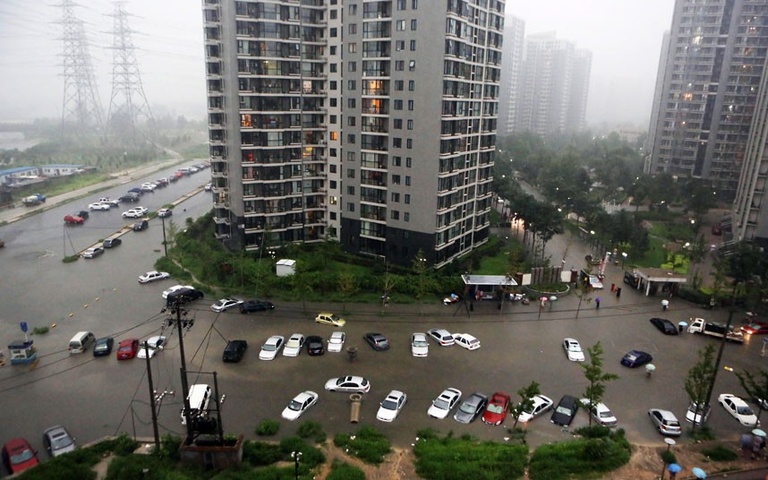This article originally appeared in the University of Iowa's IIHR-Hydroscience & Engineering blog on July 21, 2015. The original can be found here.

Flash flooding occurred in busy, downtown Beijing in July, 2012. Photo: EPA/CHING CHIN CHINA OUT
By Shianne Gruss, IIHR blog
Flooding – as humans often forget – is as natural as rain. While it has been historically common to settle on fertile floodplains to support agriculture, nature actually intended for floodplains to periodically flood, which can lead to widespread damage and even harm.
No country knows this better, perhaps, than China, where seven of the 10 most deadly worldwide flood events on record have occurred, according to data from the Centre for Research on the Epidemiology of Disasters (CRED).
“Flooding in China is a different concept,” says Yibing Su, an IIHR undergraduate research assistant. “When there’s flooding, people die.”
Before Yibing Su left her hometown of Beijing to enroll as a freshman in engineering at the University of Iowa, a major flood struck the city of 11.5 million. In a matter of hours during late July 2012, houses and businesses were destroyed, city streets turned into rivers, and many lost their lives. Su and her mother were stranded in an area downtown where flooding was less severe.
“It wasn’t that much water,” admits Su, “but in a city like Beijing, a little water leads to serious transportation problems. I just don’t think the city was designed to handle that amount of water.”
While the flash flooding was largely a result of poor drainage systems in the city, only one thing could be blamed for the particularly intense flooding that occurred in the district of Fangshan, an agricultural suburb of Beijing. The town had been built on an ancient floodplain.
“It had just been dry for a long, long time, and people forgot that it used to be a river channel,” explains Su. “So when water came, water found its way back.”
According to statistics released by the Chinese government, the 2012 flood killed 79 people, the majority of whom lived in Fangshan. However, CRED data puts total number of casualties at 151.

Su poses with Herky in the Seamans Center, where she spends most of her time at the university.
“With the dense population and the water management difficulties that come with it, floods are often much more catastrophic in China than here, in the sense of casualties,” says Su. A flood like the one that occurred in Beijing in 2012, she adds, is an indicator of the “crucial importance” of water management—a concept most people rarely think about.
Su thinks about it, however, and traveled halfway around the world to study it. She is currently pursuing the hydrology track in civil engineering and will soon begin her thesis on river temperature as a water-quality parameter. Her findings will help support the Iowa Flood Center’s new Iowa Water Quality Information System (IWQIS), which is still in development.
“It’ll connect the stream flow amounts with the nutrient level response,” explains Su. “We’ll be able to see how nutrient level changes with respect to flow and temperature.” She says that IWQIS will look very similar to the Iowa Flood Information System (IFIS).
Su says she’s looking forward to beginning work on her thesis and will spend the summer preparing herself through research. This fall will be her fourth year at the university, but her fifth in Eastern Iowa. As a junior in high school, she participated in an exchange program at Cedar Falls High School. She says living with a host family helped her learn the new culture and language. “It definitely made the transition smoother when I had to start my college life in a foreign country all by myself,” she adds.
Su is a member of the UI professional chapter of Engineers without Borders, and was a College of Engineering Student Ambassador her sophomore year. She enjoys seeing movies at the mall with her friends and playing a traditional seven-stringed Chinese musical instrument, called the Guqin, which she says is unfamiliar to many, even in China.
“If I’m not at IIHR, I’m at the Seamans Center or library,” remarks Su of her busy schedule. “Playing the Guqin or watching TV are my ways of relaxing.”